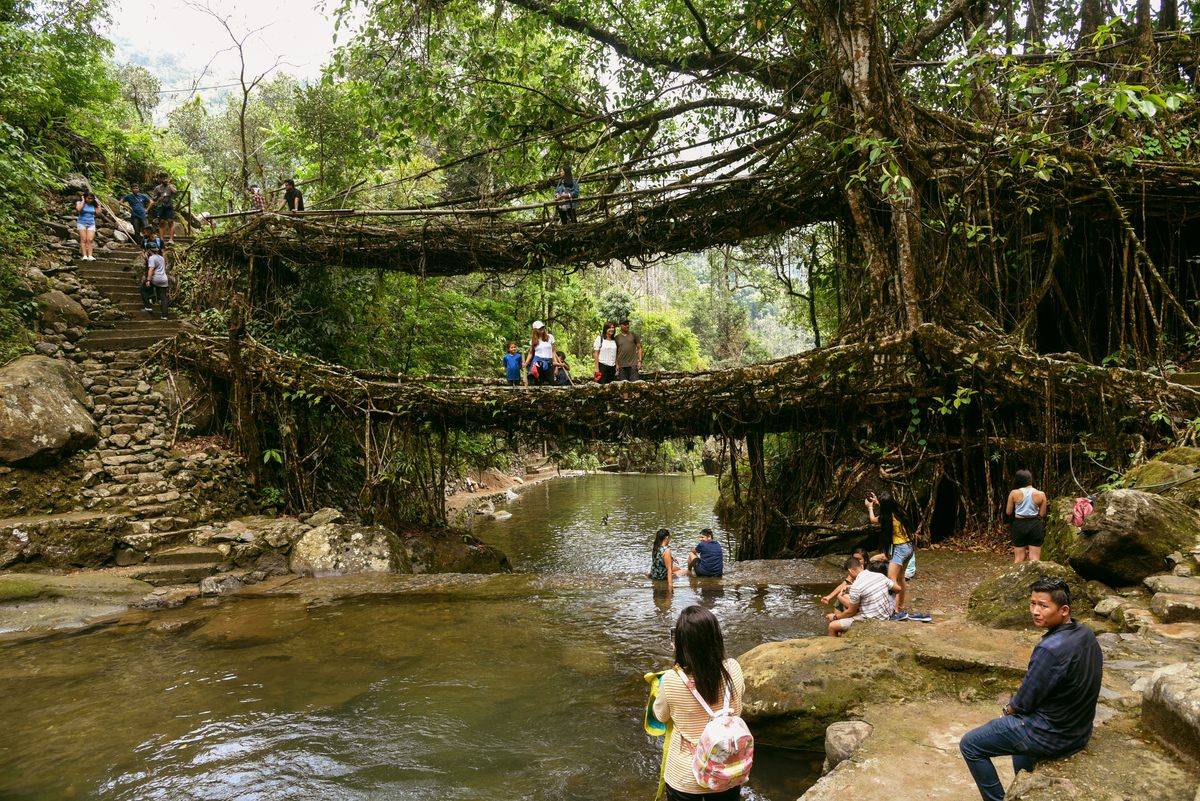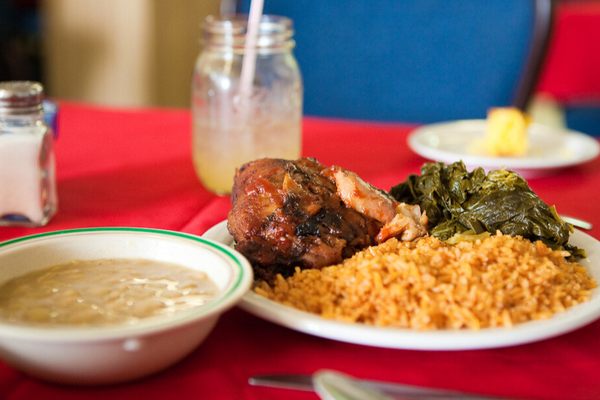
The Artisans Behind India’s Living Root Bridges
For half a century, Hally War has been growing a bridge across a local river—and between past and present.
In the dawn of times, there were sixteen primordial tribes who lived with their creator in their heavenly abode, the kingdom of clouds. One fine day, one of these men looked down and discovered a lush paradise, filled with mesmerizing waterfalls, luxurious jungle, and abundant food. He asked the creator to conceive the jingkiengjriksiar, a mythical “golden bridge” formed by a majestic tree which connected the two worlds, and moved with some human settlers into this idyllic land.
This is the kind of story that Hally War heard while growing up in northeastern India, cuddled with his siblings around the fire during the long, cold nights. War, now a 68-year-old farmer from Siej village, belongs to the Khasi tribe for whom the concept of a tree bridge is far more than just a foundational legend. For hundreds of years, his people have been not building bridges, but growing them. The jingkieng jri, as the living root bridges are locally known, seem to have sprung directly out of Tolkien’s imagination. The interwoven aerial roots create a pervading fairy-tale atmosphere, appearing to connect myth and reality and the past and the future rather than the two sides of the river.
Initially, the bridges were created for pragmatic reasons, as a strategy of adaptation to the harsh environment. The southern Khasi hills, in the Indian state of Meghalaya, experience the heaviest rainfall in the world for more than six months annually. A conventional bamboo or wood bridge would be very quickly washed away. “The indigenous builders then turned to their natural environment for harnessing the raw materials and started building structures and bridges across the streams and inhospitable terrain,” writes Ian Lyngdoh, author of the book Ficus Khasiana.

The Khasi people invented the art of weaving the roots of ficus elastica, a species of fig tree, until together they become strong enough to form a bridge. “They were great innovators with a practical outlook, and they created a culture which was unique, sustainable and ecofriendly. Inheriting a culture deeply rooted in the environment, the people developed a living architecture that was found nowhere else in terms of its application and philosophy,” Lyngdoh says. These bridges grow stronger each year for as long as the tree is alive; some bridges are estimated to be more than 500 years old and can hold up to 50 people.
Realizing how extraordinary this example of tribal botanical architecture is, India submitted a proposal in 2022 for the inclusion of the bridges among UNESCO’s World Heritage sites. The country hopes that such a designation would help to protect 72 different living bridges and other similar structures across Meghalaya. The applicants describe each living root structure as a “distinct ethno-botanical journey rooted in profound culture-nature reciprocity and synthesis,” “an apogee of human-plant relationship” and “a remarkable breakthrough in nature-based design and engineering” while also “contributing to the ecology through forest and riparian restoration.”
War started to learn how to grow a bridge at a very early age. “I was about nine years old when my grandfather showed me a living root bridge that he was growing across the Ummunoi river,” he says. Noticing the child’s interest, his grandfather, Iang Rapthap, began to share with him the secrets of his work. The old man taught War how to take advantage of the natural characteristics of the pliable aerial roots, showing him their tendency to anchor themselves to other objects and their propensity to combine with each other. The young boy learned how to channel the tiny roots through bamboo, wood, or hollowed-out palm trunks, and to arrange them into the desired architectural feature; how to support the most fragile sections of the bridge with bamboo poles until these were strong enough to hold on by themselves; and so much more.
War’s grandfather intertwined the lessons with stories from Khasi oral tradition, a fundamental tool that the Khasi people used to instruct their children about their environment and the laws of nature. “The oral tradition meant that there were no written formulas nor documentation on the science of making bridges; it was a skill, a craft, an art, a behavior pattern and an experience that was inherited, passed on from one generation to another,” says Lyngdoh. While entwining the roots, War also learned about the visible and hidden forces surrounding him: he realized which fruits and mushrooms were deadly, which plant leaves he could collect in order to prevent malaria, which ones he should harvest to treat kidney stones, and so on.

The most important lesson he learned from his grandfather, though, was the art of patience. Year after year, he watched the roots becoming bigger and stronger, as he himself was slowly growing from a small child to a young man. War understood how the diengjri—as the Khasi call the ficus elastica—was growing in a different time than his own; even if its growth was slower, it would outlast his own existence. He started to recognize the respect his people had for this tree. “The diengjri in some villages is sacred and certain rites and rituals are performed in and around the Ficus tree. It is regarded as the saviour and protector of the forest by the inhabitants,” writes Lyngdoh. For the priests of the traditional religion, “both the ficus elastica and the jingkiengjriksiar [the mythical “golden bridge”] connect the physical and spiritual world and are accorded a sacred character in the culture of the native inhabitants of the region…The imaginary umbilical cord has reincarnated itself in the Ficus tree and in the living bridges of the people.”
War’s grandfather emphasized the tree’s transcendental attributes while he was instructing him about the very first step in the process of creating a bridge: planting the seed of the diengjri near the river bank. There was a sort of taboo connected to it. “Only old men were allowed to plant this type of tree. It was believed that the roots would drain away the vital force of the young men and their possibility of generating offspring,” War recalls. This meant that the elder who planted the tree did so as a gesture towards the future generations; he would die long before the tree would be ready to be transformed into a bridge. Fortunately, War’s forefathers had foresight. His grandfather showed him the place where a member of the family had planted a seed years earlier. Once a young sapling, it was now a vigorous tree with the perfect attributes to be turned into a bridge.
So War enthusiastically began what would become his life’s work, the Umkar living root bridge. He still preserves his grandfather’s bridge, located a few miles away; but he has dedicated most of his spare time to his personal project, patiently weaving and directing the aerial roots across the river. “It took me 50 years of work to establish the first stage,” War says, “and for the last 17 years I have also been working on a second deck,” specifying that he has been developing both levels simultaneously. With time and experience, War grew even bolder. He decided to try to weave a staircase and a viewing deck directly over the small waterfall beneath. “I am even planning to add a third platform,” he says.

The bridge is still under construction, but it is already possible to carefully cross a part of it. The structure demonstrated its resilience in 2011 when a tempestuous monsoon washed away the bamboo bridge standing next to War’s creation. His bridge stood, surviving the calamity without significant damage.
His work involves several challenges. “Most of the time I work alone, and I need to carry the bamboo poles from long distances, which is quite hard during the slippery rainy season,” he explains; the entire community gathers to combine their efforts only in some specific stages of the bridge’s growth. Another problem is the damage inflicted to the structure by people who stand on fragile portions of the bridge, damaging parts which are still too tender.
The biggest threat to the existence of these structures, though, is not careless people but the passage of time. The art of weaving and preserving the living root bridges is slowly fading away. “The simplest way of looking at the cause of the disappearance of Meghalaya’s botanical architecture is to examine its primary liability, which is that it takes a very long time to become functional and safe to use,” says Patrick Rogers, founder of the Living Root Bridge project. “Even if a steel or concrete bridge is more expensive and doesn’t have the environmental benefits and longevity of a living root bridge, it will be usable much sooner.” Outside of tourist areas, the villagers often don’t see any practical reason to make the intergenerational investment in such structures, and they are abandoning the construction and maintenance of these bridges altogether.
Recently, a few individuals and organizations have started to promote the task of propagation and conservation of the living root bridges. But War began this mission long ago: “This bridge is my life’s purpose. I dream about it day and night; it has become a part of me. I will keep working on this bridge for as long as I can stand, and I will keep teaching my sons and grandsons so they can continue my work once I am gone. And I will plant a seed of the diengjri myself, so that one day someone from my offspring may grow a bridge when the time is ripe.”

































Follow us on Twitter to get the latest on the world's hidden wonders.
Like us on Facebook to get the latest on the world's hidden wonders.
Follow us on Twitter Like us on Facebook